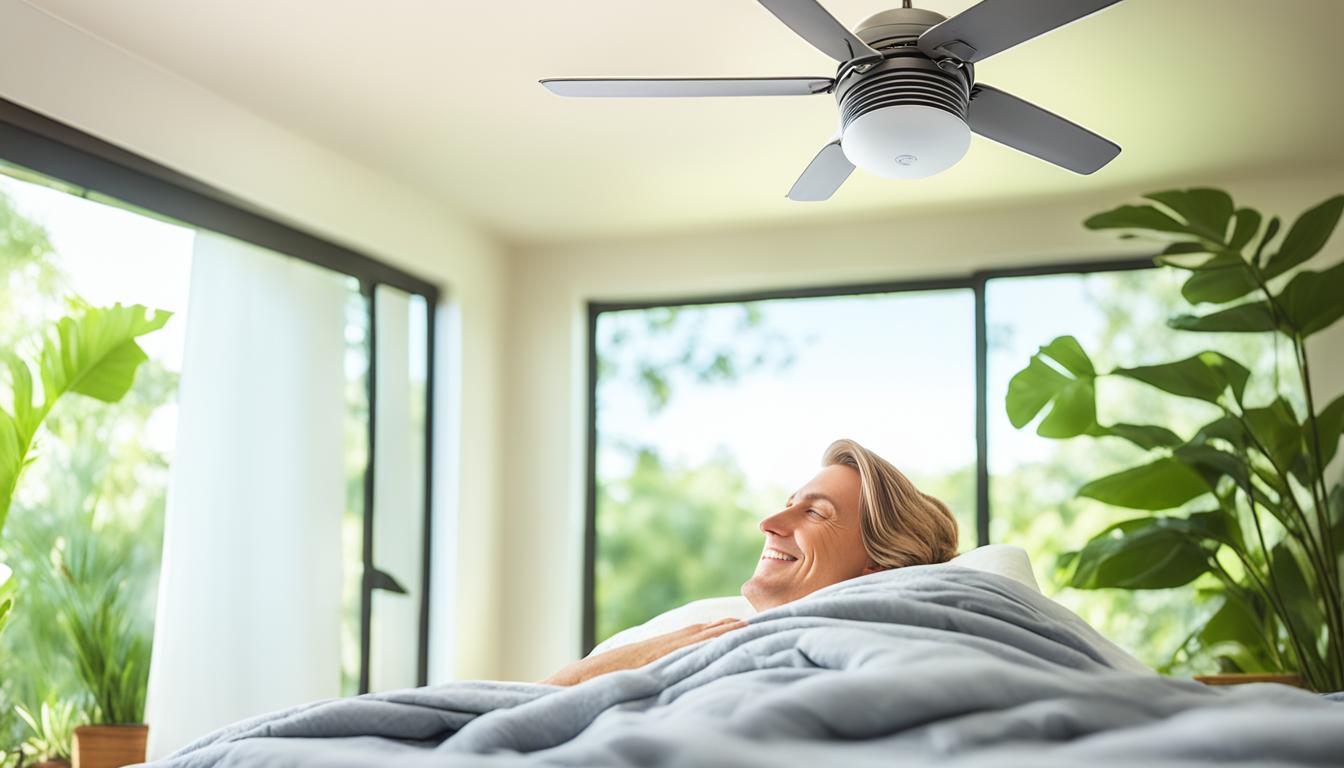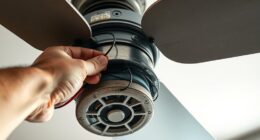Did you know that ceiling fans in the US typically have 4 or 5 blades, while Indian fans often come with just 3 blades? The difference in blade count may seem minor, but it actually has a significant impact on the performance and functionality of these fans.
When it comes to ceiling fans, the number of blades plays a crucial role in determining factors such as stability, airflow, power consumption, and noise levels. In the US, fans with more blades are often used to circulate air from an air conditioner, while in India, three-blade fans are preferred for their balance, reduced load on the motor, lower power consumption, and noise reduction.
So, why the discrepancy in blade count? The choice between a fan with 3 or 4+ blades depends on various factors, including the presence of an air conditioner, room temperature, desired air circulation, noise tolerance, and energy efficiency requirements.
Key Takeaways:
- US ceiling fans typically have 4 or 5 blades, while Indian fans often come with 3 blades.
- The number of blades affects stability, airflow, power consumption, and noise levels.
- In the US, fans with more blades are used to circulate air from an air conditioner, while in India, three-blade fans are preferred for their balance, reduced load on the motor, lower power consumption, and noise reduction.
- The choice between a fan with 3 or 4+ blades depends on factors such as the presence of an air conditioner, room temperature, desired air circulation, noise tolerance, and energy efficiency requirements.
- Consider these factors when choosing the right ceiling fan for your needs and preferences.
Working Principle Of Fan
Understanding the working principle of a fan is essential to grasp how it creates a cooling effect. The primary function of a fan is to push surrounding air or increase airflow. When the air from the fan strikes our bodies, it extracts heat and evaporates sweat, resulting in a feeling of coolness. The key principle behind a fan’s operation is the movement and circulation of air, which helps in creating this refreshing sensation.
Fans work by using the rotation of blades to move air. As the blades spin, they create a low-pressure region behind them, causing air from the surroundings to be drawn in. The air then moves towards the front of the blades, where it is pushed forward, generating airflow in the desired direction.
The concept of airflow is crucial for fans to operate effectively. By pushing air, fans create a breeze that enhances evaporation and lowers body temperature, providing relief in warm environments.
“Fans leverage the simple yet ingenious principle of air movement to provide a cooling effect in various settings.” – Airflow Expert
The working principle of a fan forms the foundation for its ability to cool and circulate air. Fan design, including blade shape, angle, and speed, can further optimize its performance and efficiency in generating airflow.
Components of a Fan:
In addition to the blades, fans consist of other essential components that contribute to their functionality:
- Motor: The motor powers the rotation of the blades, converting electrical energy into mechanical energy.
- Hub: The hub connects the blades to the motor and ensures smooth rotation.
- Base: The base provides stability and supports the fan’s overall structure.
- Casing: The casing houses the motor and other internal components, protecting them from external damage.
- Controls: Many fans come equipped with controls to adjust speed, direction, and additional features.
Understanding the working principle of a fan helps us appreciate the ingenuity behind its design and its ability to provide cooling and airflow in various environments. Fans have become an integral part of our lives, whether in homes, offices, or public spaces, offering comfort and relief during hot weather.
Number Of Blades
The number of blades on a ceiling fan has a significant impact on its performance, specifically in terms of airflow and fan stability. The blade count directly influences the fan’s ability to push air, resulting in different airflow patterns and overall cooling effectiveness.
Increasing the number of blades on a fan allows for greater air movement and higher airflow rates. This can be especially beneficial in larger rooms or spaces that require better circulation. The additional blades help to create more turbulence, effectively pushing greater volumes of air and enhancing overall cooling performance.
However, it is important to note that as the number of blades increases, the fan may become more unstable and affect its rotation speed. This is due to the increased drag caused by the additional blades. To mitigate this, fan manufacturers carefully design and balance their fans to ensure optimal performance and stability even with a higher blade count.
In addition to the number of blades, the angle between each wing of a three-blade fan also plays a crucial role in its overall performance and stability. A 60-degree angle between the blades provides better balance and reduces the load on the fan motor, resulting in smoother operation and improved fan stability.
To better understand how the number of blades impacts fan performance, refer to the table below:
| Number of Blades | Airflow | Fan Stability |
|---|---|---|
| 3 | Effective airflow | Good stability with a 60-degree blade angle |
| 4 | Increased airflow | Stable with careful design and balance |
| 5 | High airflow | Can be less stable without proper design |
As seen in the table, fans with more blades generally offer higher airflow levels, but careful consideration should be given to maintaining stability. Ultimately, the choice between a three-blade fan or a fan with more blades depends on individual preferences and specific cooling requirements.

Why are four or five-blade fans used in America?
In the United States, four or five-blade fans are widely popular due to their ability to generate increased airflow and enhance air circulation. These fans are commonly utilized alongside air conditioning units to optimize the cooling experience within a room. Unlike in some other countries where fans are predominantly used for relieving heat, American consumers prioritize the cooling effect and air movement provided by fans with more blades.

In American households, the focus is on creating a comfortable indoor environment through efficient air circulation. By using fans with four or five blades, individuals can maximize the flow of cool air in combination with an air conditioner. This combination ensures a more uniform distribution of cool air throughout the room, promoting a consistent temperature and comfortable atmosphere.
| Advantages of Four or Five-Blade Fans | Disadvantages of Four or Five-Blade Fans |
|---|---|
|
|
By choosing a fan with four or five blades, users can benefit from optimized airflow and air circulation, resulting in a more comfortable environment. However, it’s important to note that these fans may generate more noise at higher speeds and consume more electricity. Additionally, the initial cost of four or five-blade fans is typically higher compared to three-blade fans.
Which Fan Is Better?
The choice between a three-blade and a four or five-blade fan depends on your specific needs and requirements. Let’s compare the pros and cons of each:
Three-Blade Fan
- Produces less noise, making it suitable for rooms where noise levels need to be kept low.
- Reduces electricity consumption, resulting in lower energy costs.
- Ideal for rooms without air conditioning that experience excessive heat.
Four or Five-Blade Fan
- Spreads cool air quickly, making it a good choice for air-conditioned rooms.
- Provides higher airflow and circulation, enhancing the cooling effect.
- May generate more noise than three-blade fans.
- Consumes more electricity, potentially increasing energy costs.
Consider factors such as noise levels, electricity consumption, and your room’s specific requirements when selecting the ideal fan for your space.

Blades of a ceiling fan
The blades of a ceiling fan play a crucial role in the generation of airflow and cooling. While many perceive them as solely for aesthetic appeal, the blades are in fact vital components that work in conjunction with the motor to push air and create a refreshing breeze. The size and pitch angle of the blades directly impact the fan’s performance, influencing airflow and power consumption.
When it comes to ceiling fan blades, size matters. Larger blades tend to provide greater airflow due to their increased surface area and ability to move larger volumes of air. This can be especially beneficial in larger rooms or spaces where more air circulation is desired. On the other hand, smaller blades require less force for rotation and can still deliver adequate airflow in smaller areas.
The pitch angle of the blades is another critical factor to consider. Blades with a steeper pitch angle can generate stronger airflow but may also require more power to rotate. Conversely, blades with a shallower pitch angle may consume less energy but deliver less powerful airflow.
It’s worth noting that the balance between blade size, blade pitch, and motor power is crucial for optimal performance and energy efficiency. Finding the right combination can ensure sufficient airflow while minimizing noise levels and maintaining energy consumption.
Here is a visual representation of the relationship between blade size, pitch angle, and airflow:

| Blade Size | Pitch Angle | Airflow |
|---|---|---|
| Smaller Blades | Shallow Angle | Moderate Airflow |
| Larger Blades | Steeper Angle | Increased Airflow |
As shown in the table above, larger blades with a steeper pitch angle generally result in higher airflow compared to smaller blades with a shallower pitch angle. However, the specific requirements and preferences of the user should be taken into account when selecting the ideal blade size and pitch angle for a ceiling fan.
Advantages and Disadvantages of 3-Blade Fans
Three-blade fans, commonly used in Indian households, offer a range of benefits and drawbacks. Understanding these can help you make an informed decision when choosing a ceiling fan for your home.
Advantages of 3-Blade Fans
- Lightweight: 3-blade fans are designed to be lightweight, making them easy to install and transport.
- High Speed: With fewer blades, these fans can rotate at higher speeds, resulting in rapid air circulation and a cooling breeze.
- Pocket-Friendly: 3-blade fans are often more affordable compared to fans with more blades, making them a budget-friendly option.
- Energy-Efficient: Due to their high speed and efficient design, 3-blade fans consume less energy, helping reduce electricity costs.
Disadvantages of 3-Blade Fans
- Noise: Rapid rotation at high speeds can sometimes lead to increased noise levels compared to fans with more blades.
- Reduced Airflow: While 3-blade fans provide sufficient airflow for most households, they may not deliver the same level of airflow as fans with more blades.

Despite these drawbacks, many individuals appreciate the lightweight design, high speed, affordability, and energy efficiency of 3-blade fans. The decision to choose a 3-blade fan ultimately depends on personal preferences, room size, desired airflow, noise tolerance, and budget considerations.
Advantages and Disadvantages of 4-Blade Fans
Four-blade fans offer unique benefits and drawbacks that make them popular choices in countries with cooler climates. Let’s take a closer look at the advantages and disadvantages of these fans.
Advantages of 4-Blade Fans
- Less Noisy: Four-blade fans operate at a slower and more consistent speed, resulting in reduced noise levels. This makes them ideal for bedrooms, living rooms, or any area where a quieter environment is preferred.
- Pairing with Air Conditioners: These fans complement air conditioners exceptionally well. They help circulate cool air without generating additional noise, enhancing the overall cooling effect in a room.
- Higher Air Delivery: With four blades, these fans can generate higher airflow and deliver a more robust breeze, making them effective in providing increased comfort and air circulation.
Disadvantages of 4-Blade Fans
- Higher Cost: Compared to three-blade fans, four-blade models tend to be pricier. The extra blade requires additional materials and manufacturing, contributing to the higher cost.
- Not Energy-Efficient: Four-blade fans consume more power compared to their three-blade counterparts. This can result in higher electricity bills over time, making them less energy-efficient.
Despite their higher cost and lower energy efficiency, the advantages of 4-blade fans, such as reduced noise levels, improved air delivery, and compatibility with air conditioners, make them a preferred choice for those seeking enhanced comfort and cooling capabilities.
Keep in mind that when choosing between different fan models, considering factors like room size, noise tolerance, desired airflow, and energy consumption is essential. Balancing these factors with personal preferences will help you make an informed decision.
| Advantages | Disadvantages |
|---|---|
| Less noisy operation | Higher cost |
| Pair well with air conditioners | Not energy-efficient |
| Higher air delivery |

Conclusion
Choosing the right ceiling fan involves considering various factors to ensure optimal performance and satisfaction. One of the key factors to consider is the blade count, whether it’s a three-blade fan or a four or five-blade fan. The number of blades impacts airflow, stability, and noise levels. In the US, fans with more blades are commonly used to enhance air circulation in conjunction with air conditioning units, while in India, three-blade fans are preferred for their balance, reduced motor load, lower power consumption, and noise reduction. Additionally, the ceiling fan’s motor efficiency and speed settings also play a pivotal role in achieving the desired cooling effect and energy savings. Another important aspect to evaluate is the ceiling fan direction for summer, as setting the fan to spin counterclockwise helps push cool air downward, creating a refreshing breeze. Considering these factors ensures you select a ceiling fan that perfectly suits your climate and functional needs.
Aside from blade count, motor quality is another crucial consideration. A high-quality motor ensures smooth operation, prolonged lifespan, and efficient performance. Additionally, energy efficiency is an essential aspect to look for in a ceiling fan. Investing in an energy-efficient model can lead to significant savings on electricity bills and reduce environmental impact.
Ultimately, the decision on which ceiling fan to choose depends on personal preferences and specific requirements. Factors such as room size, desired airflow, noise tolerance, energy consumption, and budget should all be taken into account. By carefully considering these factors and referring to this ceiling fan buying guide, individuals can confidently select a fan that meets their needs, whether it’s a three-blade fan for efficient cooling or a four or five-blade fan for enhanced air circulation.






